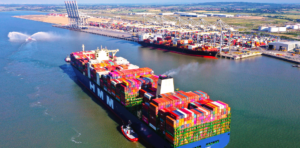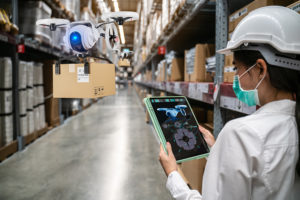The fifth-generation of cellular internet connectivity, 5G, is set to bring in major changes across transport. How will it impact the logistics industry?
Eusebiu Catana, Senior Manager, I&D, ERTICO
Digital logistics is one of the big promises of 5G and comes with potentially great efficiencies and benefits. The logistics industry is essential for the European economy and for economic growth: 74% of goods exported or imported to the European Union are transported via its seaports. At the same time, the challenges they face are only getting greater. Cargo volumes are increasingly higher (with an expected 57% rise by 2030) while they are also arriving in a shrinking number of vessels: the next generation of post-Panamax vessels have a capacity of more than 18,000 containers. But cargo volumes are not just increasing; cargo flow types are also changing due to technological trends, such as Industry 4.0. Moreover, cargo port operators need to comply with increasingly stricter environmental regulations and societal
views for sustainable operations.

5G is the convergence technology for the new generation of mobile networks. It promises to address the diverse and rather demanding performance requirements of a wide range of use cases, in terms of data rates, capacity, security, reliability, availability, latency and impact on battery life. To date, though, the number of 5G trials has not exploded, raising some concerns about the actual capability in monetising the appointed use cases. The latter, known as ‘5G paradox’, seems not to justify a quick roll-out of 5G in any developed country.
In the framework of ERTICO’s 5G projects, a strategic and innovative framework was proposed, addressing the integration and validation of technologies as part of an overall architecture representing a subset of 5G network functions. All the ERTICO 5G projects support 5G technological blocks, including new generation of 5G terminals for future Connected and Automated Mobility (CAM), new types of IoT-5G devices, data analytics, next-generation traffic management and emerging subsets of 5G networks functions, for port areas and city ports to handle upcoming and future capacity, traffic, efficiency and environmental challenges.
Certainly, the most important policy at European level is the European Green Deal, aiming at full decarbonisation by 2050, where we will strongly contribute to decarbonising one of the most carbon-intense fields – transport. This will be done by supporting multi-modal transport and supporting three European ports in showcasing 5G-enabled solutions for reductions in CO2 emissions.
Sultan Ahmed Bin Sulayem, Group Chairman & CEO, DP World
With speeds of up to 100 times faster than 4G, 5G will improve data latency and capacity, allowing more devices to stay connected to the internet via the IoT.
It will also bring about changes for traditional warehousing practices and make smart warehouses a much more common feature in the transport industry. Although the rollout of 5G is still in its infancy and coverage limited, it’s not too early to start planning for what will be a truly transformative change for industry.
We have already begun to think about how to work with businesses to help them adapt for this change. Our joint enterprise with DHL Supply Chain, for example, has anticipated the rollout of 5G and included it in almost every part of the warehouse design at DP World’s London Gateway. At 428,000ft2, it will be the single largest unit and has an internal volume of 645 Olympic swimming pools. But it also represents a significant investment in automation and fully embracing 5G.
Due for operation in early-2023, full planning permission was received for the warehouse in just 24 days. Our plan is to work with existing and prospective clients on a range of build-to-suit solutions with fast delivery from agreement for lease, so they are able to adapt to the demands of this new, faster-paced world.
It is our intention that companies seek to partner with DP World to future-proof their businesses. By using our expertise, we believe we can smooth the flow of goods and use our resources to help drive corporate growth.
With the fourth industrial revolution in full swing, we’re beginning to see how technology is having an impact on how we live.
One way in which this has been most obvious is through the growth in popularity of online shopping. Everything from a pint of milk to the latest best-seller can be ordered, paid for and delivered to your front door.
E-commerce has been growing steadily over the past decade but soared as the pandemic took hold. Sales have rocketed as people have been forced off the High Street and into their homes by lockdowns and through social distancing. During the third quarter alone, the US Department of Commerce reported e-commerce sales of US$209.5 billion – slightly lower than the US$211.6 billion recorded during the second quarter but 36.7% higher than a year earlier.
And, representing just 14.3% of total retail sales currently, there is still plenty of room for future growth as consumers become more comfortable with shopping online.
Yet, as e-commerce has grown in popularity, it has also led to challenges for traditional warehousing methods. To meet those, the transportation industry and its use of warehousing will have to change.
With greater numbers shopping online, manufacturers and retailers must scale-up their warehousing operations, particularly as consumers increasingly expect same-day delivery. This could be expensive and with labour representing the greatest operating cost in warehouses, increased automation in warehouses is likely to become far more common.
Consultancy McKinsey states that €300 billion in costs are incurred in running warehouses, globally, in a recent report. It found more than 85% of this is spent on operating costs, which include labour, space and equipment required to receive, sort, store, pick, pack and finally dispatch products.
Automation could be a game-changer, ridding businesses of many of these costs. It would likely impact other areas too – mistakes will be fewer and productivity will likely be enhanced. It is no surprise, then, that automated warehouses are becoming more common.
The introduction of 5G will likely accelerate this automation process.
Siraj Ahmed Shaikh, Director of Research, Coventry University
The current HGV driver shortage is the latest chapter in the UK’s supply chain jitters and calls into question the long-term viability of logistical transportation on the roads.

One intuitive long-term solution to future HGV driver shortages is to take the driver out of the driver’s seat altogether. Self-driving car technology – which can also be applied to HGVs – promises to bring about substantial change to how we transport people and goods. But, despite advances, self-driving vehicles remain distrusted and difficult to build. One possible solution sits at the very interface of technology with the human: teleoperation, or the replacement of the behind-the-wheel driver with a combination of automation technology and remote-controlled human oversight.
We’re involved in work trialling this approach as a more realistic, less-distant solution to crises in road logistics in the coming years.
There has long been a desire to create intelligent and autonomous HGVs. A decade ago, the Safe Road Trains for The Environment project set out to understand the feasibility of road trains, or ‘platoons’. In this case, the lead vehicle in the platoon controls all those behind it, with a gap maintained and altered when other vehicles pass between them.

Teleoperation is currently being trialled in north-east England, where a 40-tonne HGV is being piloted over
a 5G communication network. The £4.8 million project is funded by the UK’s Department for Digital, Culture, Media & Sport to realise the benefits of cutting-edge developments in both telecoms and vehicular teleoperation. Such a combination of emerging technologies could result in optimal route planning, reduced emissions, reduced labour movement and safer journeys. The teleoperated lorry is being put through its paces at the Nissan test track in Sunderland as part of a ‘last-mile delivery’ system – transporting goods on the final, shortest leg of their journey – to support manufacturing logistics. It’s a fitting example of how human effort can be relieved from the most intensive stage of the logistical chain.
To bring this vision to reality, retailer Wilko has made a £3 million investment into StreetDrone – one of the partners with us on the teleoperated HGV project. StreetDrone aims to bring the tech to UK roads by the end of 2023, albeit initially in smaller vehicles than HGVs.
Patrick Hirscher, EMEA LTE/5G Market Development Manager, Zyxel
5G is a nearly inconceivably large step up from 4G. It’s been growing so rapidly exactly because it delivers quantum leaps in capacity and data rates that are enabling new applications and unlocking more potential. We expect some of 5G’s most significant impacts to be in industrial applications, especially the manufacturing and logistics industries.
It’s making the transition to Industry 4.0 and smart factory automation not just possible but practical. The factory of the future is people and machines working safely together
to increase productivity, improve efficiency and produce goods in a way that meets carbon-neutrality goals. When integrated into smart factory solutions, 5G’s faster speeds, lower latency and greater bandwidth enable you to increase throughput by minimising the amount of downtime required for maintenance and by enabling faster changes to the production line.Further, logistics warehouse and factory sites need more than only indoor connectivity for inventory check-ups and barcode scanning. They also have to connect with their outdoor storage spaces and trucks on the road. Here, 5G allows the automation of manufacturing and supply chain management to more effectively collect and process data, and to sync the real-time movement of trucks.
I think network slicing is a killer app for 5G. Such a large number of wired and wireless WLANs can lead to patchy internet that will randomly drop out at any time. However, a 5G private network can provide a service that avoids delay and interference and maintains security.
5G is also an optimal choice as the primary WAN for new factories as its large capacity and low latency can achieve manufacturing and supply chain automation for real-time vehicle movement monitoring and data synchronisation.











